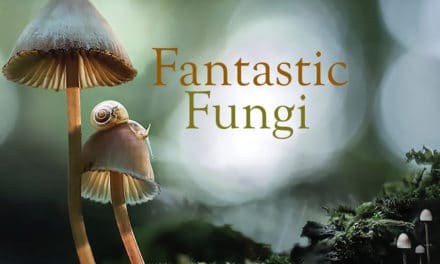
God Creates Plants, Great Canterbury Psalter, England, circa 1200 The Psychedelic Gospels shows many examples of mushroom art in early Christianity.
Did psychedelic mushrooms play a central role in early Christianity, and could they have been a key factor in Jesus’ awakening and message? According to Jerry and Julie Brown, there is a wealth of evidence that suggests the answer is a resounding “yes.”
In The Psychedelic Gospels: The Secret History of Hallucinogens in Christianity, anthropologist Jerry Brown, Ph.D. and his wife, coauthor, and holistic psychotherapist Julie Brown, M.A. make a compelling case for these extraordinary claims with a page-turning investigative adventure that recounts their travels across Europe to famous and lesser-known churches, and their research into biblical verses, early illuminated manuscripts, and psychedelic history.
As a vast and charged subject with many points of evidence to consider, we spoke with Jerry Brown at length about his and his wife’s discoveries and how they all interrelate. This is the first of four articles that will cover their journey and the incredible amount of evidence they have gathered ranging from the speculative to the irrefutable.
Thank you so much for speaking with us, Jerry. I really enjoyed reading this book that you and your wife put together. Can you give us an overview of what role you feel psychedelic mushrooms played in early Christianity and in Jesus’ life?
I feel we have compelling evidence that psychedelics played a significant role in the history of Christianity, and that these rites were conducted for the initiates in secret. As with many shamanic practices, such as those of tribes like the Mazatec in Mexico, and in mystery cults like the Eleusinian Mysteries, psychedelic mushrooms were the ‘holy of the holies’ as revealed by hints in the gospels and clear representations in the artwork.
We do not have- and I believe it would be very difficult to discover- a “smoking gun” going back to the time of Jesus and his disciples. But my coauthor and wife Julie and I believe that psychedelics were instrumental in Jesus’ awakening and his sense of divinity and immortality. We present passages from both the New Testament gospels and the gnostic gospels in the chapter of our book called “The Kingdom of Heaven” that we feel give strong evidence that both Jesus and his disciples were aware of the visionary power of entheogens. And when you look at the fact that Christianity emerged in a circum-Caribbean circum-Mediterranean area that was rife with mystery cults, it is not in any way improbable.

Julie Brown, M.A. and Jerry Brown, Ph.D., authors of The Psychedelic Gospels
Here is a quote from the Gospel of Thomas that we cite in our book. Jesus tells Thomas: “Compare me to someone and tell me who I am like. Thomas said to him, ‘My mouth is wholly incapable of saying who you are like.’ Jesus said, ‘I am not your master because you have drunk; you have become intoxicated from the bubbling spring from which I have measured out. He who will drink from my mouth, he shall become like me, I shall become like he, and the things that are hidden will be revealed to him.” So we’re talking about something that is ‘measured out’- that’s a dose, and he knows the dose, and they are having a transpersonal merging of souls, which leads us to believe this is strong evidence of an entheogenic experience. And we cite several other quotes too. When Jesus is talking about “Eat of my flesh and drink of my blood” he can’t be talking about cannibalism- this would be repugnant to both Romans and Jews alike. So we believe this was metaphorical for psychoactive mushrooms.
And then, you fast forward to things like the ‘Miracle of Marsh Chapel’, the Good Friday experiment, which showed definitively in a double-blind experiment that psilocybin causes an authentic mystical experience not distinguishable from the experiences of mystics recorded through the ages. Huston Smith, the famous scholar of religion who was a participant as a divinity student in that study, said this was the most cosmic homecoming that he ever experienced. In other words, he was saying this was a direct experience of what he had been reading about in his studies as a Christian. This is a profound connection.
We also have to remember that in early shamanism, a principal purpose for psychedelics is for healing, and certainly Jesus was known for his healing abilities. When we get to the Canterbury Psalter, an illuminated book of prayers from 1180, there is an amazing illustration in that book of Jesus healing the leper, but what’s interesting here is that the scroll in the leper’s left hand translates as “Master, if you want you may cleanse me,” but it is not pointed at Jesus, but rather merges with a tan mushroom at the base of the panel. Then Jesus’ scroll says “I want to be cleansed” and we think that the artists who put other significant psychedelic mushrooms in the Canterbury Psalter is obviously saying we’re at the part of Jesus’ life where he has recognized the power of psychedelic mushrooms in the healing process.

Healing of the Leper, Great Cantebury Psalter, folio 3, England, circa 1200
The last point I’d like to make here is that we agree with Gordon Wasson and others who hold a strong entheogen theory that psychoactive plants were instrumental in the origins of many religious traditions, and therefore we feel a sameness here between Christianity and other religious practices. We’re not here to challenge anyone’s belief in Christianity, but rather to reveal a mystery that we believe is present in many religions.
You can learn more about Jerry and Julie Brown’s work on their website here. Stay tuned to Psychedelic Times to read our further conversations with Jerry Brown about the presence of Amanita muscaria and psilocybin mushrooms in early Christian art, the secret psychedelic initiations of early Christianity, and new revelations about famed ethnomycologist Gordon Wasson.









